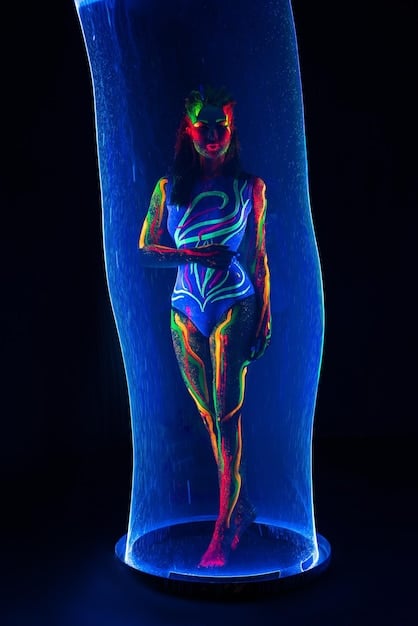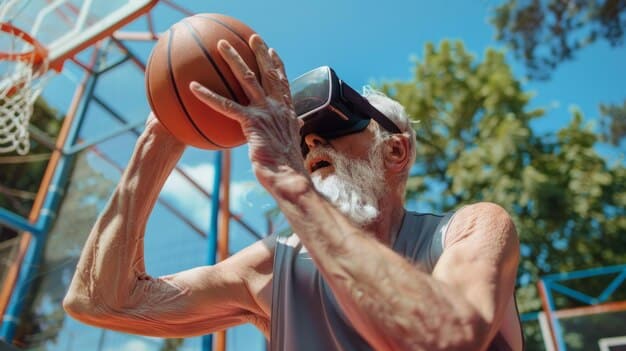Elite Biometrics: Optimizing Athlete Training & Injury Prevention

Elite athletes leverage cutting-edge biometric technologies, including advanced wearables, sophisticated motion capture systems, and genomic profiling, to gain unparalleled insights into their physiological responses, optimize training loads, and preemptively mitigate injury risks, revolutionizing performance science.
In the relentless pursuit of peak performance, elite athletes and their support teams are constantly seeking an edge. This quest has led to a profound integration of data-driven methodologies, where Insider Knowledge: Unveiling the Cutting-Edge Biometric Technologies Used by Elite Athletes to Optimize Training and Prevent Injuries has become indispensable. These advanced tools offer an unprecedented look into the intricate workings of the human body, transforming how training is designed and how injuries are anticipated and avoided.
The Dawn of Data-Driven Performance: Biometrics in Elite Sports
The landscape of professional sports has unequivocally shifted from anecdotal coaching to precision science. Biometric technologies are at the forefront of this revolution, providing objective, quantifiable data that was once unimaginable. This data empowers coaches, trainers, and medical staff to make informed decisions, moving beyond guesswork to targeted interventions.
For elite athletes, every millisecond, every degree of joint movement, and every physiological marker counts. Biometrics offers a granular view of an athlete’s physical state, allowing for hyper-personalized training regimes. This meticulous approach is not just about enhancing capability but also about safeguarding the athlete’s career by meticulously managing their physical well-being.
Wearable Technology: The Athlete’s Digital Sentinel
Wearable devices have transcended basic fitness tracking. In elite sports, they are sophisticated tools that collect a myriad of physiological data points, almost acting as digital sentinels. These devices provide continuous feedback, allowing for immediate adjustments to training intensity and recovery protocols.
- 🏃♂️ Real-time Heart Rate Variability (HRV): Reflects the body’s acute stress and recovery status, guiding daily training load adjustments.
- ⚡ GPS and Accelerometers: Track speed, distance, acceleration, deceleration, and changes in direction, crucial for understanding movement economy and fatigue.
- 💧 Continuous Glucose Monitoring (CGM): Offers insights into an athlete’s metabolic response to training and nutrition, optimizing fueling strategies.
Beyond the simple data points, these wearables often integrate complex algorithms to interpret vast datasets, presenting actionable insights. This immediate feedback loop is critical for mitigating overtraining syndrome and ensuring athletes are optimally prepared for competition. The goal is to walk a fine line: push boundaries without crossing into the realm of detrimental stress.
The progression of wearable technology continues at a rapid pace. Newer generations incorporate even more intimate data collection, from sweat analysis to skin temperature variations, painting an ever more complete picture of the athlete’s internal state. This breadth of data supports a holistic approach to athlete management, where physical, psychological, and nutritional factors are all considered in real-time.
Advanced Motion Capture & Biomechanical Analysis: Precision in Movement
Understanding how an athlete moves is paramount to both performance optimization and injury prevention. Advanced motion capture systems go beyond the human eye, dissecting movement with unparalleled precision. These technologies identify subtle inefficiencies and biomechanical flaws that might otherwise go unnoticed, but which can lead to significant issues over time.
Optical motion capture, utilizing multiple high-speed cameras and reflective markers, creates a 3D model of an athlete’s movements. This virtual representation allows for meticulous analysis of joint angles, forces, and movement patterns. Such detailed insight is invaluable for refining technique in sports like golf, baseball pitching, or running, where minuscule deviations can impact performance and increase injury risk.
Pressure Mapping Systems: Understanding Ground Reaction Forces
Invisible to the naked eye, the forces exerted between an athlete’s foot and the ground (or hand and object) are critical. Pressure mapping systems, often integrated into insoles or training surfaces, precisely measure these ground reaction forces, offering deep insights into weight distribution and pressure points during dynamic movements.
For example, in running, uneven pressure distribution can indicate muscular imbalances or improper gait mechanics, predisposing an athlete to shinsplints, patellofemoral pain, or even stress fractures. By visualizing these pressure patterns, experts can tailor corrective exercises and modify footwear, enhancing both efficiency and safety. The ability to see minute variations in force application provides a tangible pathway for intervention.

Beyond foot pressure, systems exist for analyzing pressure on handle grips for sports like tennis or golf, or even seat pressure in cycling. Each application aims to perfect the interaction between the athlete and their equipment or environment, thereby maximizing power transfer and minimizing stress on the body. This level of detail in biomechanical analysis separates elite training from traditional methods, making the invisible visible for strategic intervention.
Ultimately, the objective is to optimize movement efficiency and reduce undue stress on an athlete’s musculoskeletal system. This proactive approach significantly lowers the incidence of overuse injuries, extending an athlete’s career longevity. The precision offered by these systems allows for adjustments that can have profound long-term benefits, protecting their most valuable asset – their body.
Physiological Monitoring Beyond the Basics: Deeper Insights
While heart rate and GPS are foundational, elite sports delve into more complex physiological monitoring to truly understand an athlete’s internal state. These advanced techniques provide a window into recovery, fatigue, and adaptation, enabling coaches to fine-tune training protocols and intervene before problems arise.
Lactate threshold testing, once confined to specialized labs, can now be integrated into field tests with portable analysers. This identifies the point at which an athlete’s body produces more lactate than it can clear, a critical marker for endurance capacity and training zones. Understanding this threshold allows for precise targeting of aerobic and anaerobic systems, optimizing performance development.
Genomic Profiling: Personalized Blueprint for Training
The nascent field of genomic profiling offers a glimpse into an athlete’s unique genetic predispositions. While still an evolving area, it holds the promise of truly personalized training and nutrition strategies. Genes can influence everything from muscle fiber type distribution to nutrient metabolism and injury susceptibility.
For instance, genetic markers might indicate a propensity for faster recovery from strength training or a higher risk of ligament injuries. While not deterministic, this information can inform proactive measures, such as emphasizing specific types of recovery, tailoring conditioning to fortify vulnerable areas, or optimizing macronutrient intake based on an individual’s metabolic profile. It adds another layer of personalization to an already nuanced training regimen.
- 🧬 Injury Susceptibility: Identifying genetic predispositions to certain types of injuries (e.g., Achilles tendon ruptures).
- 🍎 Nutrient Metabolism: Understanding how an athlete processes carbohydrates, fats, and proteins for optimized dietary planning.
- 💪 Recovery Rates: Guiding individualized rest periods and recovery modalities based on genetic markers for muscle repair.
However, ethical considerations and the probabilistic nature of genetic data mean it’s used as a guide rather than a definitive roadmap. It complements, rather than replaces, traditional physiological testing and coaching intuition. The complexity of gene-environment interactions means that while genetics can reveal potential, environmental factors like training and nutrition ultimately unlock it.
The integration of deep physiological data, from metabolic markers to genetic insights, allows for a truly bespoke approach to athlete development. It moves beyond a one-size-fits-all model, recognizing each athlete as a unique biological entity with specific needs and responses. This precision helps in pushing individual limits while maintaining optimal health.
Neuroscience & Cognitive Biometrics: The Mental Edge
Performance in elite sports isn’t solely physical; the mental game is equally crucial. Biometrics are increasingly being used to monitor and enhance cognitive functions, stress response, and decision-making under pressure. This holistic view recognizes the interplay between mind and body, leveraging technology to sharpen an athlete’s mental edge.
Electroencephalography (EEG) headsets, while less common in daily training environments, are used in controlled settings to analyze brainwave activity. This can provide insights into an athlete’s focus, anxiety levels, and ability to enter “flow states” – periods of optimal performance. Techniques like neurofeedback, based on EEG data, can help athletes train their brains to better manage stress and enhance concentration.
Eye-Tracking Technology: Deciphering Visual Cues
In sports where rapid decision-making is key, such as basketball, soccer, or tennis, eye-tracking technology reveals where an athlete’s gaze is directed. This can pinpoint areas of delayed recognition or inefficient visual search patterns, offering insights into how they process information and anticipate opponents’ moves.
For example, a quarterback reviewing game footage with eye-tracking data can see if they are focusing too long on a specific receiver, making their intentions obvious, or if they are failing to scan the field effectively. This feedback is invaluable for improving peripheral awareness, decision speed, and deceptive tactics. It illuminates the cognitive aspect of movement, helping athletes “see” the game more effectively.

Combining physiological and cognitive biometric data provides a truly comprehensive profile of an athlete. It highlights not just physical capabilities but also mental resilience, processing speed, and the ability to perform under duress. Training with this cognitive feedback allows athletes to develop both their physical and mental strength in parallel, creating a more robust and adaptable competitor.
The insights from cognitive biometrics extend to managing performance anxiety and improving clutch performance. By understanding how an athlete’s brain responds to pressure, sport psychologists and coaches can implement targeted interventions, from mindfulness techniques to mental rehearsal, ensuring athletes are as prepared mentally as they are physically for high-stakes competition.
Injury Prediction & Prevention: Proactive Health Management
Perhaps one of the most significant impacts of biometric technologies in elite sports is their role in injury prediction and prevention. Moving beyond reactive treatment, these tools enable proactive health management, identifying risk factors and potential issues before they escalate into debilitating injuries. This capability protects athletes’ careers and ensures their availability for critical competitions.
Predictive analytics, fed by vast amounts of historical and real-time biometric data, can identify patterns that precede injury. Factors like sudden drops in heart rate variability, prolonged high training loads with insufficient recovery, or subtle changes in biomechanical markers can trigger alerts, prompting immediate intervention. The goal is to catch nascent problems before they sideline an athlete.
Automated External Defibrillators (AEDs) & Real-Time Cardiac Monitoring
While not a direct training optimization tool, advanced biometric monitoring in sports also encompasses critical health safety. Wearable devices now offer real-time cardiac monitoring, detecting irregular heart rhythms or signs of cardiac distress. In conjunction with readily available Automated External Defibrillators (AEDs) at training facilities and events, these technologies enhance athlete safety by providing early warning and immediate life-saving capabilities.
For athletes with known or suspected cardiac issues, continuous ECG monitoring within a training environment provides peace of mind and enables immediate medical response should an anomaly occur. This focus on immediate emergency response is a critical, albeit often unheralded, aspect of how biometrics safeguard elite athletes’ lives.
- 🩺 Stress Load Index: Algorithms analyze multiple inputs (HRV, sleep, training load) to quantify total physiological stress, flagging potential overtraining.
- 📉 Biomechanical Anomaly Detection: AI-powered systems identify subtle deviations in movement patterns indicative of impending injuries (e.g., knee valgus during landing).
- 🛌 Recovery Optimization Protocols: Personalized plans based on sleep quality, physiological markers, and perceived exertion to accelerate recovery and reduce fatigue.
The shift from injury treatment to injury prediction is a paradigm change. Instead of waiting for an athlete to break down, the data allows for “prehab” interventions, corrective exercises, and strategically modulated training loads to build resilience in vulnerable areas. This foresight not only prevents downtime but also allows for more consistent performance development.
The ultimate aim is to create an environment where athletes can push their physical limits responsibly, confident that their well-being is being continuously monitored and optimized. This proactive approach to health underscores the profound value of integrated biometric technologies in protecting the most valuable asset in sports: the athlete’s body and career.
Challenges & Future Outlook: Hitting the Next Frontier
While biometric technologies have revolutionized elite sports, their implementation is not without challenges. Data privacy, the ethical use of sensitive information, and the inherent variability of human physiology present ongoing considerations. Striking a balance between maximizing insights and respecting individual autonomy is key.
The sheer volume of data generated by these systems also demands sophisticated analytical capabilities and well-trained personnel to interpret it effectively. Without expert analysis, raw data remains mere numbers. The human element – the coaches, sports scientists, and medical staff – remains indispensable in translating data into actionable strategies and maintaining a holistic view of the athlete.
Ethical Considerations of Data Privacy and Usage
As biometric data becomes more granular and personal (e.g., genomic data), the ethical implications surrounding its collection, storage, and use become more pronounced. Athletes’ rights to privacy, data security against breaches, and fair use of this information by teams and organizations are paramount. Clear policies and transparent communication are essential to build trust and ensure responsible innovation.
Another aspect is the potential for data to be used to make decisions that go beyond medical or performance optimization, such as draft selection or contract negotiations. Safeguards must be in place to prevent misuse and ensure that data serves the athlete’s best interests first and foremost. The future of biometrics in sports depends on navigating these ethical landscapes responsibly.
Looking ahead, the convergence of AI, machine learning, and biometric data promises even more precise and predictive capabilities. AI algorithms can identify subtle correlations and predict injury risks with greater accuracy than ever before, moving beyond basic pattern recognition to true predictive modeling. This will allow for hyper-individualized training prescriptions that adapt in real-time to an athlete’s physiological state.
Furthermore, non-invasive sensing techniques are becoming more sophisticated, allowing for continuous and seamless data collection without interfering with an athlete’s performance or comfort. Miniaturization, improved battery life, and enhanced data transmission will further integrate these technologies into the daily lives of elite athletes, making real-time insights an omnipresent reality. The future holds the promise of truly symbiotic relationship between athlete and technology.
| Key Area | Brief Description |
|---|---|
| 🚀 Performance Optimization | Biometrics refine training loads, technique, and recovery for peak athletic output. |
| 🩹 Injury Prevention | Early detection of stress and biomechanical flaws mitigates injury risks. |
| 🧠 Cognitive Enhancement | Tools like eye-tracking and EEG sharpen mental processing and decision-making. |
| 🧬 Personalized Training | Genomic profiling and detailed physiological data enable bespoke training plans. |
Frequently Asked Questions About Biometric Technologies in Elite Sports
▼
Elite athletes utilize a range of biometric technologies, including advanced wearables for heart rate and GPS tracking, sophisticated motion capture systems for biomechanical analysis, and specialized physiological monitors for lactate and oxygen consumption. Emerging areas also include genomic profiling and cognitive biometrics like eye-tracking for comprehensive insights.
▼
Biometric technologies optimize training by providing real-time data on an athlete’s physiological response, movement efficiency, and recovery status. This allows coaches to customize training loads, refine technique, identify fatigue signals, and implement targeted recovery strategies, ensuring that every training session contributes optimally to performance improvement while minimizing overtraining risks.
▼
While no technology can guarantee complete injury prevention, biometrics significantly enhance proactive injury mitigation. By continuously monitoring biomechanical changes, physiological stress, and recovery markers, these systems can identify early warning signs of potential issues. This enables coaches and medical staff to intervene with corrective exercises or rest before minor problems escalate into serious injuries, thereby protecting athletes’ careers.
▼
Yes, significant ethical concerns exist, particularly regarding data privacy and the potential misuse of sensitive information like genomic data. Ensuring the secure storage of data, maintaining transparency about its usage, and establishing clear consent protocols are crucial. The balance between leveraging data for performance and respecting athlete autonomy remains a critical ethical consideration in this evolving field.
▼
The future of biometrics in elite sports is likely to see further integration of Artificial Intelligence and machine learning for even more precise predictive analytics. Non-invasive, continuous monitoring will become more sophisticated, seamlessly integrated into athletes’ daily routines. The focus will continue to be on hyper-personalization, proactive health management, and unlocking even deeper insights into human potential.
Conclusion
The integration of cutting-edge biometric technologies has fundamentally reshaped the landscape of elite sports. From optimizing training and enhancing recovery to proactively preventing injuries, these tools provide an unparalleled depth of insight into the athlete’s physical and mental state. While challenges remain, particularly around data ethics and interpretation, the undeniable value proposition of biometrics ensures their continued evolution and indispensable role in pushing the boundaries of human performance. The future of sports belongs to those who successfully harness this powerful combination of athletic prowess and scientific precision.





